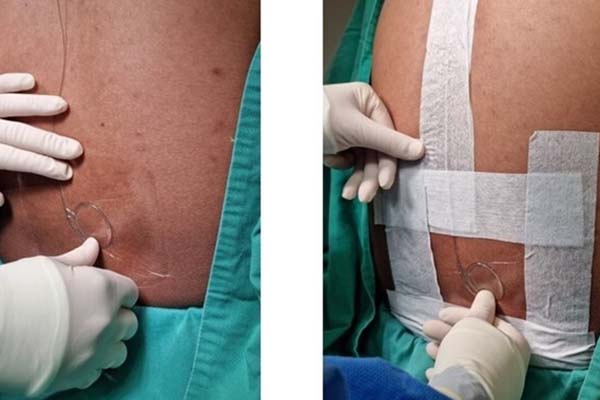Keywords
Abstract
Continuous spinal anaesthesia (CSA) is a cardio-stable technique used in high-risk patients undergoing surgery. However, this technique appeared to decline over the last decades due concerns of complications that arise from using this technique, such as post-dural puncture headaches and neurological deficits. We report two cases of elderly patients, one at high cardiac risk and one with dementia and multiple comorbidities, under CSA for orthopaedic surgery with no reported complications. CSA is an adequeate anaesthetic technique with a low failure rate and complications. Proper technique should be taken into consideration to increase the success rate for this procedure.
References
Elfeky MA, Stohy SM, Sabra MM, et al. Randomised comparison of continuous spinal anesthesia versus continuous epidural anesthesia in high-risk elderly patients undergoing major orthopedic lower limb surgeries. Research and Opinion in Anesthesia & Intensive Care. 2019;6(1):72-79.
Jain SP, Naik R, Bhagat C, et al. Effect of Continuous Spinal Anesthesia and Single Shot Spinal Anesthesia on Hemodynamics for Lower Abdominal and Hip Surgeries in Adults: An Observational Study. J Anesth Clin Care. 2019;6:039.
Gregory A, Stapelfeldt WH, Khanna AK, et al. Intraoperative Hypotension Is Associated with Adverse Clinical Outcomes After Noncardiac Surgery. Anesth Analg. 2021;132(6):1654-65. https://doi.org/10.1213/ANE.0000000000005250
Rigler ML, Drasner K, Krejcie TC, et al. Cauda equina syndrome after continuous spinal anaesthesia. Anesth Analg. 1991;73(3):275-81. https://doi.org/10.1213/00000539-199103000-00001
Spannella F, Giulietti F, Damiani E et al. Thoracic continuous spinal anesthesia for high-risk comorbid older patients undergoing major abdominal surgery: one-year experience of an Italian geriatric hospital. Minerva Anestesiol. 2020;86(3):261-69. https://doi.org/10.23736/S0375-9393.19.13896-5
Castellani D, Starnari R, Faloia L, et al. Radical cystectomy in frail octogenarians in thoracic continuous spinal anesthesia and analgesia: a pilot study. Ther Adv Urol. 2018;10(11):343–49. https://doi.org/10.1177/1756287218795427
White SM, Moppett IK, Griffiths R, et al. Secondary analysis of outcomes after 11,085 hip fracture operations from the prospective UK Anaesthesia Sprint Audit of Practice (ASAP-2). Anaesthesia. 2016;71(5):506-14. https://doi.org/10.1111/anae.13415
Regional Anesthesiology and Acute Pain Medicine. Continuous Spinal Anaesthesia (Spinal Catheter Technique). 10 October 2021. YouTube. Available from: https://youtu.be/3knfs02LQcI. Accessed: 22 November 2022.
D’Ambrosio A, Spadaro S, Natale C, et al. Continuous spinal analgesia with levobupivacaine for postoperative pain management: Comparison of 0.125% versus 0.0625% in elective total knee and hip replacement: A double-blind randomised study. J Anaesthesiol Clin Pharmacol. 2015;31(4):478-84. https://doi.org/10.4103/0970-9185.169066
Matturu S, Singam A, Madavi S, et al. Continuous Spinal Anesthesia Technique After Accidental Dural Puncture. Cureus. 2022;14(9):e29046. https://doi.org/10.7759/cureus.29046







